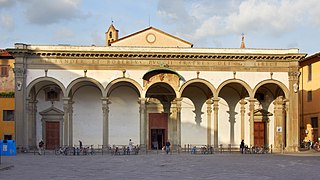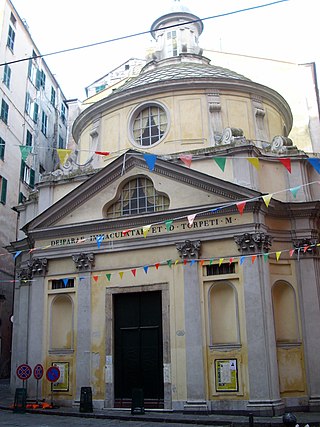Description
Of the Gothic building, the nave, aisles and the façade are in white (marble) and black (slate) stripes, divided into three sectors by fake columns with Lombard bands; in the center is a large rose window, while on the sides are two double mullioned windows. The façade includes a late Roman sarcophagus with an Allegory of the Autumn, which originally was used as the tomb of Lamba Doria, who had taken it to Genoa from Korčula in Dalmatia. At one time, large chains, which once had protected the harbor of Pisa and which had been obtained as booty after the victory at the Battle of Meloria (1284), were draped across the facade. In the 19th century, they were returned to Pisa. [1]
On the left side of the church is the cloister of St. Matthew, of quadrangular plan, dating to 1308. It has ogival arches on double small columns.
Artworks of the interior include the Miracle of the Ethiopian Dragon by Luca Cambiaso and the Vocation of St. Matthew by Giovanni Battista Castello, a wooden "Deposition" by Anton Maria Maragliano, and the tomb of Andrea Doria, executed by Montorsoli, in the crypt. At the high altar is a Holy Family with St. Anne by Bernardo Castello (16th century). According to the tradition, the sword housed under the altar belonged to Andrea Doria, and was donated to this church by Pope Paul III. The church has an original organ, constructed by Antonio Alari in 1773.

Santa Maria Novella is a church in Florence, Italy, situated opposite, and lending its name to, the city's main railway station. Chronologically, it is the first great basilica in Florence, and is the city's principal Dominican church.

The Basilica della Santissima Annunziata is a Renaissance-style, Catholic minor basilica in Florence, region of Tuscany, Italy. This is considered the mother church of the Servite Order. It is located at the northeastern side of the Piazza Santissima Annunziata near the city center.

Luca Cambiaso was an Italian painter and draughtsman and the leading artist in Genoa in the 16th century. He is considered the founder of the Genoese school who established the local tradition of historical fresco painting through his many decorations of Genoese churches and palaces. He produced a number of poetic night scenes. He was a prolific draughtsman who sometimes reduced figures to geometric forms. He was familiarly known as Lucchetto da Genova.

Giovanni Battista Castello was an Italian historical painter.
Bernardo Castello (1557–1629) was an Italian painter of the late-Mannerist style, active mainly in Genoa and Liguria. He is mainly known as a portrait and historical painter.

Pisa Cathedral is a medieval Catholic cathedral dedicated to the Assumption of the Virgin Mary, in the Piazza dei Miracoli in Pisa, Italy, the oldest of the three structures in the plaza followed by the Pisa Baptistry and the Campanile known as the Leaning Tower of Pisa. The cathedral is a notable example of Romanesque architecture, in particular the style known as Pisan Romanesque. Consecrated in 1118, it is the seat of the Archbishop of Pisa. Construction began in 1063 and was completed in 1092. Additional enlargements and a new facade were built in the 12th century and the roof was replaced after damage from a fire in 1595.

Diano Castello is a comune (municipality) in the Province of Imperia in the Italian region Liguria, located about 90 kilometres (56 mi) southwest of Genoa and about 5 kilometres (3 mi) northeast of Imperia. As of 31 December 2004, it had a population of 2,061 and an area of 6.0 square kilometres (2.3 sq mi).

Genoa Cathedral or Metropolitan Cathedral of Saint Lawrence is a Roman Catholic cathedral in the Italian city of Genoa. It is dedicated to Saint Lawrence, and is the seat of the Archbishop of Genoa. The cathedral was consecrated by Pope Gelasius II in 1118 and was built between the twelfth century and the fourteenth century as fundamentally a medieval building, with some later additions. Secondary naves and side covers are of Romanesque style and the main facade is Gothic from the early thirteenth century, while capitals and columns with interior corridors date from the early fourteenth century. The bell tower and dome were built in the sixteenth century.

The Basilica della Santissima Annunziata del Vastato is the Catholic cathedral of Genoa, northern Italy; its decoration employed the major baroque studios and artists in Genoa in the 17th century.

San Torpete is a church in central Genoa, northern Italy, dedicated to Saint Torpes. It was founded in the 11th century by local merchants. It was rebuilt in 1730 under designs conceived by Giovanni Antonio Ricca.

San Francesco della Vigna is a Roman Catholic church in the Sestiere of Castello in Venice, northern Italy.

The Sanctuary of Nostra Signora della Misericordia is a church and surrounding buildings located some six kilometers from the center of Savona, Liguria, northern Italy.

Sant'Agostino is a church in the historical center of Genoa, northern Italy. It is today deconsecrated, sometimes used for representations of the nearby Teatro della Tosse theatre company.

Santa Maria di Nazareth is a Renaissance church in the town of Sestri Levante, in the Gulf of Tigullio in the Metropolitan City of Genoa. Located in the center of the old village of Sestri Levante, adjacent to the town hall, its parish community is part of the Diocese of Chiavari.

Santa Maria delle Vigne is a Roman Catholic basilica church in Genoa, Italy. It was built in the 10th century. The main altar was completed in 1730 by Giacomo Antonio Ponsonelli. The church is also the final resting place of the leading early Italian composer Alessandro Stradella, who was murdered in 1682.

San Sisto is a Roman Catholic church in Genoa, Italy, located in Centro-Est quartiere of Prè, near the railway station of Genova Piazza Principe.
San Domenico is a Renaissance and Gothic style, consecrated Roman Catholic church and former monastery. It is located on the corner of Largo Monsignor Muzi and Via Luca Signorelli, and adjacent to the Piazza di San Giovanni in Campo, in the center of Città di Castello, region of Umbria, Italy.
The Diocesan museum of Genoa is located in Genova in the region of Liguria. It is found inside the old residence of the canons of the Cathedral of San Lorenzo and is accessible through the cloister of San Lorenzo. The cloister, built in the 12th century, is characterized by two levels of arches resting on double Romanesque columns with leaved capitals. In the 17th century two sides of the building were modified, with the double columns substituted with heavy pilasters in order to support the above two floors constructed for additional space. The museum houses objects from the diocese of Genoa and the surrounding area, including sculptures, paintings, frescoes, illuminated manuscripts, and a series of liturgical items, as well as an archeological area.

The Palazzo Vincenzo Imperiale is a building in Campetto at number 8a, in the area of the Soziglia Market in the historical centre of Genoa. The building was included in the list of palaces included in the Rolli di Genova, UNESCO World Heritage List sites. Designed and decorated in the second half of the 16th century by Giovan Battista Castello, it constitutes one of the major Mannerist creations in Liguria.

The Villa del Principe, Palazzo del Principe, or Palace of Andrea Doria in Fassolo is one of the main historical suburban villas of Genoa, Italy. It was built in the 16th century in an area that it is now located in the city center, but at the time of the construction of the villa was just outside of the city walls towards Capo di Faro and the Lanterna.

















